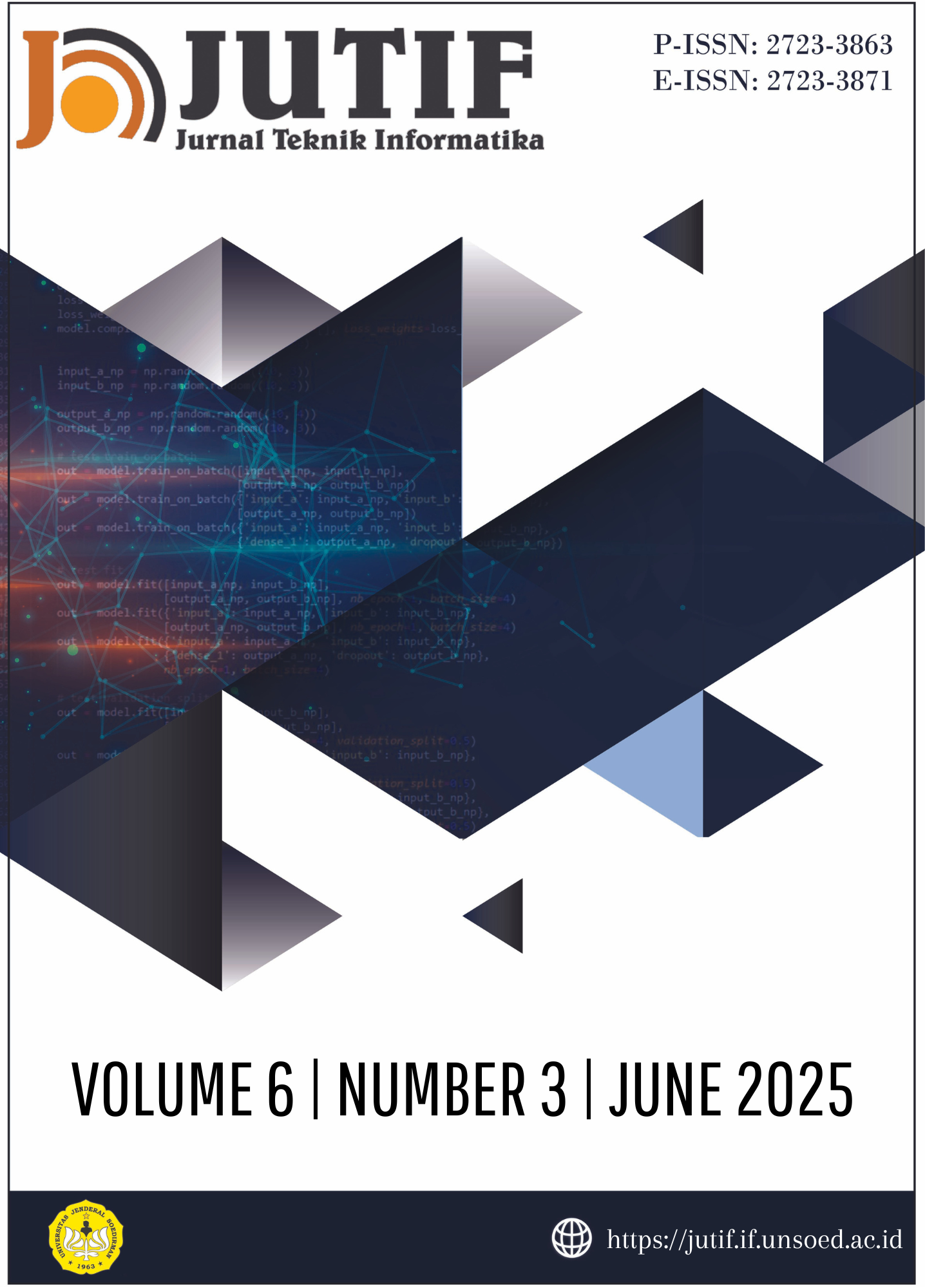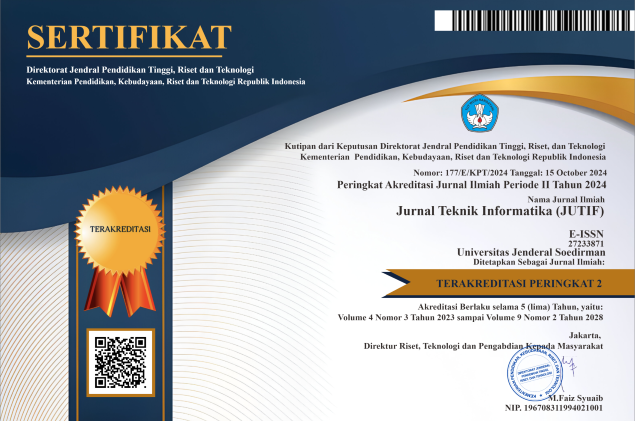Leveraging Convolutional Block Attention Module (Cbam) For Enhanced Performance In Mobilenetv3-Based Skin Cancer Classification
DOI:
https://doi.org/10.52436/1.jutif.2025.6.3.4546Keywords:
Bayesian optimization, CBAM, ISIC 2024 SLICE-3D, MobileNetV3, Skin cancer classificationAbstract
As the incidence of skin cancer continues to rise globally, effective automated classification methods become crucial for early detection and timely intervention. Lightweight neural networks such as MobileNetV3 offer promising solutions due to their minimal parameters, making them suitable for environment with low resource. This study aims to develop an automated multiclass skin cancer classification system by enhancing MobileNetV3 with the Convolutional Block Attention Module (CBAM). The primary goal is to achieve high classification accuracy without significantly increasing computational demands. We employed Bayesian optimization to automatically fine-tune model parameters and applied targeted data augmentation techniques to address class imbalance. CBAM was integrated to highlight diagnostically relevant regions within images. The proposed method was evaluated using the ISIC 2024 SLICE-3D dataset, which includes over 400,000 dermatoscopic images categorized into benign, basal cell carcinoma, melanoma, and squamous cell carcinoma classes. Preprocessing involved standardized resizing, normalization, and extensive geometric and photometric augmentations. Results demonstrated that our method achieved an accuracy of 98.97%, precision of 98.99%, recall of 98.97%, and an F1-score of 98.98%, surpassing previous state-of-the-art models by 1.86–6.52%. Remarkably, this improvement was achieved with minimal additional parameters due to the effective integration of CBAM. These results represent an advancement in automated medical image analysis, particularly for low resource settings, by combining lightweight CNNs with attention mechanisms and systematic hyperparameter exploration.
Downloads
References
Global Cancer Observatory, “Melanoma of Skin Fact Sheet,” 2022, World Health Organization. [Online]. Available: https://gco.iarc.who.int/media/globocan/factsheets/cancers/16-melanoma-of-skin-fact-sheet.pdf
G. C. Observatory, “Melanoma of Skin Fact Sheet,” 2022, World Health Organization. [Online]. Available: https://gco.iarc.who.int/media/globocan/factsheets/cancers/16-melanoma-of-skin-fact-sheet.pdf
N. Hasan et al., “Skin cancer: understanding the journey of transformation from conventional to advanced treatment approaches,” Mol Cancer, vol. 22, no. 1, p. 168, Mar. 2023, doi: 10.1186/s12943-023-01854-3.
B. Arouch and M. Elboim-Gabyzon, “The role of physical therapists in the early detection of skin melanoma: insights from an anonymous survey,” Front Med (Lausanne), vol. 11, Mar. 2024, doi: 10.3389/fmed.2024.1436206.
S. Kam and J. Zic, “42855 To ABCDE or not to ABCDE?: a Randomized Educational Intervention Study to Improve Patient Recognition of Atypical Nevi,” J Am Acad Dermatol, vol. 89, no. 3, p. AB98, Mar. 2023, doi: 10.1016/j.jaad.2023.07.394.
M. A. Khan, T. Akram, Y.-D. Zhang, and M. Sharif, “Attributes based skin lesion detection and recognition: a mask RCNN and transfer learning-based deep learning framework,” Pattern Recognit Lett, vol. 143, pp. 58–66, 2021.
P. P. Naik, “Cutaneous Malignant Melanoma: A Review of Early Diagnosis and Management,” World J Oncol, vol. 12, no. 1, pp. 7–19, 2021, doi: 10.14740/wjon1349.
T. Tran et al., “Expert Consensus Statement on Proficiency Standards for Dermoscopy Education in Primary Care,” The Journal of the American Board of Family Medicine, vol. 36, no. 1, pp. 25–38, Mar. 2023, doi: 10.3122/jabfm.2022.220143R1.
A. Ennaji, E. H. Khoukhi, M. A. Sabri, and A. Aarab, “Malignant melanoma detection using multi-scale image decomposition and a new ensemble-learning scheme,” Multimed Tools Appl, vol. 83, no. 7, pp. 21213–21228, 2023.
D. J. Derwin, O. J. Singh, B. P. Shan, K. U. Maheswari, and D. Lavanya, “An efficient multi-level pre-processing algorithm for the enhancement of dermoscopy images in Melanoma detection,” Med Biol Eng Comput, vol. 61, no. 11, pp. 2921–2938, 2023.
A. Muh. F. and H. M. and D. H. Asfar, “COMBINATIONS OF FEATURE EXTRACTIONS AND MACHINE LEARNING ALGORITHMS FOR SKIN CANCER CLASSIFICATION,” Jurnal Teknik Informatika (JUTIF), vol. 5, pp. 1591–1598, Dec. 2024.
N. Faujdar, R. Agrawal, and A. Agarwal, “Critical analysis of various supervised machine learning algorithms for detecting diabetic retinopathy in images,” in Artificial Intelligence and Machine Learning Techniques in Image Processing and Computer Vision, Apple Academic Press, 2024, pp. 75–93.
R. Kulkarni, S. Giri, S. Sanghvi, and R. Keskar, “Classification of Malignant Skin Cancer Lesion Using CNN, KNN, and SVM,” 2023, pp. 731–742. doi: 10.1007/978-981-19-6631-6_50.
A. Yilmaz, M. Kalebasi, Y. Samoylenko, M. E. Guvenilir, and H. Uvet, “Benchmarking of Lightweight Deep Learning Architectures for Skin Cancer Classification using ISIC 2017 Dataset,” Mar. 2021.
R. Agrawal, N. Gupta, and A. S. Jalal, “CACBL-Net: a lightweight skin cancer detection system for portable diagnostic devices using deep learning based channel attention and adaptive class balanced focal loss function,” Multimed Tools Appl, Mar. 2024, doi: 10.1007/s11042-024-19485-1.
A. Pandey, M. S. Teja, P. Sahare, V. Kamble, M. Parate, and M. F. Hashmi, “Skin cancer classification using non-local means denoising and sparse dictionary learning based CNN,” Journal of Electrical Systems and Information Technology, vol. 11, no. 1, p. 36, Mar. 2024, doi: 10.1186/s43067-024-00162-0.
K. DeVoe, G. Takahashi, E. Tarshizi, and A. Sacker, “Evaluation of the precision and accuracy in the classification of breast histopathology images using the MobileNetV3 model,” J Pathol Inform, vol. 15, p. 100377, Dec. 2024, doi: 10.1016/j.jpi.2024.100377.
U. K. Lilhore et al., “A precise model for skin cancer diagnosis using hybrid U-Net and improved MobileNet-V3 with hyperparameters optimization,” Sci Rep, vol. 14, no. 1, p. 4299, Mar. 2024, doi: 10.1038/s41598-024-54212-8.
Y. Liu, P. Xiao, J. Fang, and D. Zhang, “A Survey on Image Classification of Lightweight Convolutional Neural Network,” in 2023 19th International Conference on Natural Computation, Fuzzy Systems and Knowledge Discovery (ICNC-FSKD), 2023, pp. 1–10. doi: 10.1109/ICNC-FSKD59587.2023.10281072.
B. Jiang et al., “Research on facial expression recognition algorithm based on improved MobileNetV3,” EURASIP J Image Video Process, vol. 2024, no. 1, p. 22, Mar. 2024, doi: 10.1186/s13640-024-00638-z.
L. Jia et al., “MobileNetV3 With CBAM for Bamboo Stick Counting,” IEEE Access, vol. 10, pp. 53963–53971, 2022, doi: 10.1109/ACCESS.2022.3175818.
S. Woo, J. Park, J.-Y. Lee, and I. S. Kweon, “CBAM: Convolutional Block Attention Module,” 2018, pp. 3–19. doi: 10.1007/978-3-030-01234-2_1.
L. Chen, H. Yao, J. Fu, and C. T. Ng, “The classification and localization of crack using lightweight convolutional neural network with CBAM,” Eng Struct, vol. 275, p. 115291, Mar. 2023, doi: 10.1016/j.engstruct.2022.115291.
P. Bhuyan, P. K. Singh, and S. K. Das, “Res4net-CBAM: a deep cnn with convolution block attention module for tea leaf disease diagnosis,” Multimed Tools Appl, vol. 83, no. 16, pp. 48925–48947, Mar. 2023, doi: 10.1007/s11042-023-17472-6.
E. H. Houssein, D. A. Abdelkareem, G. Hu, M. A. Hameed, I. A. Ibrahim, and M. Younan, “An effective multiclass skin cancer classification approach based on deep convolutional neural network,” Cluster Comput, Jun. 2024, doi: 10.1007/s10586-024-04540-1.
D. Wen et al., “Characteristics of publicly available skin cancer image datasets: a systematic review,” Lancet Digit Health, vol. 4, no. 1, pp. e64–e74, Mar. 2022, doi: 10.1016/S2589-7500(21)00252-1.
N. R. Kurtansky et al., “The SLICE-3D dataset: 400,000 skin lesion image crops extracted from 3D TBP for skin cancer detection,” Sci Data, vol. 11, no. 1, p. 884, Aug. 2024, doi: 10.1038/s41597-024-03743-w.
U. Kumar Lilhore et al., “A precise model for skin cancer diagnosis using hybrid U-Net and improved MobileNet-V3 with hyperparameters optimization,” Sci Rep, vol. 14, no. 1, p. 4299, Feb. 2024, doi: 10.1038/s41598-024-54212-8.
L. Jia et al., “MobileNetV3 With CBAM for Bamboo Stick Counting,” IEEE Access, vol. 10, pp. 53963–53971, 2022, doi: 10.1109/ACCESS.2022.3175818.
International Skin Imaging Collaboration (ISIC), “ISIC 2024 - Skin Cancer Detection with 3D-TBP.”
W. N. Ismail and H. A. Alsalamah, “Efficient Harris Hawk Optimization (HHO)-Based Framework for Accurate Skin Cancer Prediction,” Mathematics, vol. 11, no. 16, p. 3601, Aug. 2023, doi: 10.3390/math11163601.
C. Xin et al., “An improved transformer network for skin cancer classification,” Comput Biol Med, vol. 149, p. 105939, Oct. 2022, doi: 10.1016/j.compbiomed.2022.105939.
R. O. Ogundokun et al., “Enhancing Skin Cancer Detection and Classification in Dermoscopic Images through Concatenated MobileNetV2 and Xception Models,” Bioengineering, vol. 10, no. 8, p. 979, Aug. 2023, doi: 10.3390/bioengineering10080979.
S. P. G. Jasil and V. Ulagamuthalvi, “A hybrid CNN architecture for skin lesion classification using deep learning,” Soft comput, Mar. 2023, doi: 10.1007/s00500-023-08035-w.
M. Saeed, A. Naseer, H. Masood, S. U. Rehman, and V. Gruhn, “The Power of Generative AI to Augment for Enhanced Skin Cancer Classification: A Deep Learning Approach,” IEEE Access, vol. 11, pp. 130330–130344, 2023, doi: 10.1109/ACCESS.2023.3332628.
E. S. Nugroho, I. Ardiyanto, and H. A. Nugroho, “Boosting the performance of pretrained CNN architecture on dermoscopic pigmented skin lesion classification,” Skin Research and Technology, vol. 29, no. 11, Nov. 2023, doi: 10.1111/srt.13505.
A. Naeem, T. Anees, M. Fiza, R. A. Naqvi, and S.-W. Lee, “SCDNet: A Deep Learning-Based Framework for the Multiclassification of Skin Cancer Using Dermoscopy Images,” Sensors, vol. 22, no. 15, p. 5652, Jul. 2022, doi: 10.3390/s22155652.
Additional Files
Published
How to Cite
Issue
Section
License
Copyright (c) 2025 Anas Rachmadi Priambodo, Chastine Fatichah

This work is licensed under a Creative Commons Attribution 4.0 International License.



























